How To Remove Wannacry Ransomware From Windows 7
What is WannaCry?
Discovered by GrujaRS and belonging to the Phobos family, WannaCry (also known every bit WannaCryFake) is software categorized as ransomware. This malicious programme encrypts files and keeps them locked unless the victim pays a ransom (purchases decryption software/tool).
WannaCry creates a ransom bulletin that tin exist viewed past opening the "info.hta" file. Information technology as well renames all encrypted files by calculation a string of random characters, an email address, and the ".WannaCry" extension to the filenames. For example, "sample.jpg" becomes "sample.jpg.[BFEBFBFF000906E9][recoverydata54@protonmail.com].WannaCry".
To receive instructions about how to pay for decryption, victims must contact WannaCry developers via the recoverydata54@protonmail.com e-mail address or Telegram account called @data54. Information technology is stated that the toll of decryption depends on how quickly these cyber criminals are contacted (victims are encouraged to brand contact immediately).
WannaCry developers promise to send a decryption tool after payment, which must be made using Bitcoins. As 'proof' that these cyber criminals have a valid tool that can decrypt files, they offer complimentary decryption of five files, which can exist sent prior to payment. Victims are warned not to attempt to decrypt data using third party software, since this might cause permanent information loss.
Generally, only the cyber criminals who develop the ransomware have tools that can decode files encrypted by their software. These programs use strong encryption algorithms that are commonly incommunicable to 'crevice'. Note that no cyber criminals tin be trusted.
They often send no tools to decrypt data, fifty-fifty if their demands are met. To avoid being scammed, do not pay and restore your files from a fill-in.
Screenshot of a message encouraging users to pay a ransom to decrypt their compromised data:
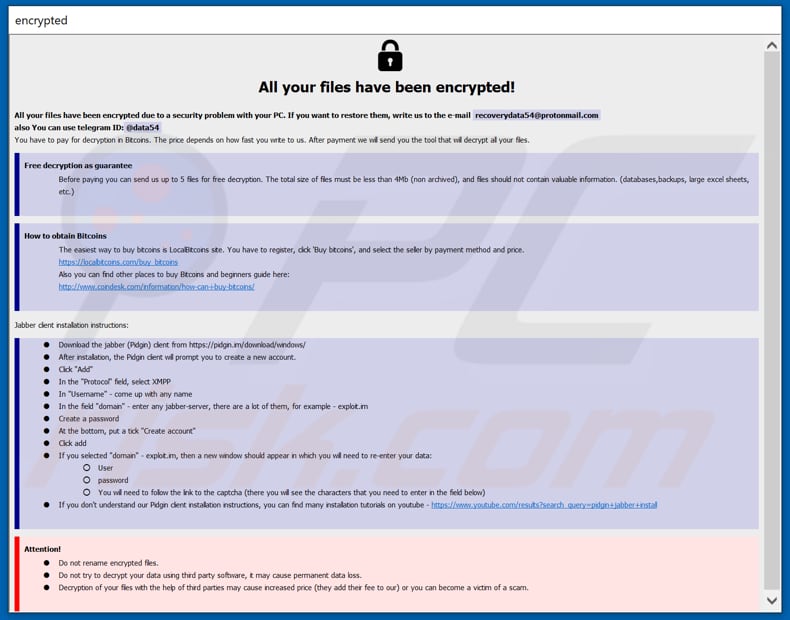
Other examples of programs categorized every bit ransomware are Money, Ebola, and Domn. Typically, these malicious programs have ii main things in common: they encrypt data and allow developers to force victims to pay a bribe. Mutual differences are cryptographic algorithm (symmetric or asymmetric) used for encryption and cost of a decryption tool/key.
In most cases, victims cannot decrypt their files without the involvement of ransomware developers, unless the program is not fully adult, contains bugs/flaws, and and so on. To avoid data loss acquired past ransomware, maintain regular backups and store them on remote servers or unplugged storage devices.
How did ransomware infect my calculator?
It is unknown exactly how cyber criminals proliferate WannaCry, however, these malicious programs are distributed through spam campaigns, Trojans, untrustworthy software download channels, software 'cracking' (activation) tools, and fake software updaters.
To proliferate malicious programs via spam campaigns, cyber criminals transport emails that contain malicious attachments. These are usually Microsoft Part documents, PDF files, archives (ZIP, RAR), executable files (.exe and others), JavaScript, and others. If opened, these infect computers with malware.
If installed, trojans cause chain infections. A trojan is malicious software designed to install additional malware. Peer-to-Peer networks (torrent clients, eMule, and then on), freeware or complimentary file hosting websites, 3rd party downloaders, unofficial websites and other channels of this blazon are as well used to distribute malware.
Cyber criminals upload malicious files that, if opened, install unwanted, malicious software. Unofficial software activation tools supposedly allow users to avoid having to pay for activation of licensed software, even so, they tin can proliferate and install malware.
Faux (unofficial) software updaters damage systems past exploiting flaws/bugs of installed, outdated software, or they simply install malware rather than the updates, fixes, and so on.
| Proper name | WannaCry (also known as WannaCryFake) virus. |
| Threat Type | Ransomware, Crypto Virus, Files locker. |
| Encrypted Files Extension | .WannaCry |
| Ransom Enervating Bulletin | info.hta file |
| Cyber Criminal Contact | recoverydata54@protonmail.com and Telegram (@data54). |
| Detection Names | Avast (Win32:Malware-gen), BitDefender (Generic.Ransom.WCryG.3D9A4E8B), Emsisoft (Generic.Bribe.WCryG.3D9A4E8B (B)), Kaspersky (HEUR:Trojan-Ransom.MSIL.Crypren.gen), Full List Of Detections (VirusTotal) |
| Rogue Procedure Name | Windows Defender (WannaCry uses the proper name of a legitimate Windows process). Its proper noun might vary. |
| Symptoms | Cannot open up files stored on your computer, previously functional files now take a different extension (for instance, my.docx.locked). A bribe demand bulletin is displayed on your desktop. Cyber criminals demand payment of a ransom (usually in bitcoins) to unlock your files. |
| Distribution methods | Infected email attachments (macros), torrent websites, malicious ads. |
| Damage | All files are encrypted and cannot be opened without paying a ransom. Additional password-stealing trojans and malware infections tin can exist installed together with a ransomware infection. |
| Malware Removal (Windows) | To eliminate possible malware infections, browse your reckoner with legitimate antivirus software. Our security researchers recommend using Philharmonic Cleaner. |
How to protect yourself from ransomware infections
Do not open up attachments that are presented in suspicious and/or irrelevant emails, especially if they are received from unknown addresses. Typically, cyber criminals disguise their emails/attachments equally important, official, etc. Update installed software using implemented functions or tools designed by official developers.
Do non use other third party, unofficial tools. All software should exist downloaded from official websites. The other tools or sources mentioned in a higher place should not exist trusted. Activate software properly. Do not apply 3rd party/unofficial tools, since this is illegal and often leads to installation of malicious programs.
Have reputable anti-spyware or anti-virus software installed, go along it upward-to-appointment, and scan the operating system with it regularly. If your computer is already infected with WannaCry, nosotros recommend running a browse with Philharmonic Cleaner Antivirus for Windows to automatically eliminate this ransomware.
Text presented in WannaCry ransom message ("info.hta" file)
All your files have been encrypted!
All your files take been encrypted due to a security trouble with your PC. If you lot want to restore them, write us to the e-mail recoverydata54@protonmail.com
also You can use telegram ID:@data54
You have to pay for decryption in Bitcoins. The cost depends on how fast you write to us. After payment we volition send you lot the tool that will decrypt all your files.
Gratis decryption as guarantee
Before paying you can ship usa upwards to 5 files for gratuitous decryption. The full size of files must be less than 4Mb (not archived), and files should non contain valuable data. (databases,backups, large excel sheets, etc.)
How to obtain Bitcoins
The easiest way to buy bitcoins is LocalBitcoins site. You lot have to register, click 'Buy bitcoins', and select the seller by payment method and price.
https://localbitcoins.com/buy_bitcoins
Also you tin discover other places to purchase Bitcoins and beginners guide here:
http://www.coindesk.com/information/how-tin can-i-buy-bitcoins/
Jabber client installation instructions:
Download the jabber (Pidgin) client from https://pidgin.im/download/windows/
After installation, the Pidgin customer volition prompt you to create a new account.
Click "Add together"
In the "Protocol" field, select XMPP
In "Username" - come up up with any name
In the field "domain" - enter any jabber-server, in that location are a lot of them, for case - exploit.im
Create a password
At the bottom, put a tick "Create account"
Click add
If y'all selected "domain" - exploit.im, so a new window should appear in which you will need to re-enter your data:
User
password
You will need to follow the link to the captcha (in that location you will see the characters that you lot need to enter in the field beneath)
If you don't sympathise our Pidgin client installation instructions, you can observe many installation tutorials on youtube - https://world wide web.youtube.com/results?search_query=pidgin+jabber+install
Attention!
Do not rename encrypted files.
Do not try to decrypt your data using third political party software, it may cause permanent data loss.
Decryption of your files with the help of tertiary parties may cause increased price (they add their fee to our) or you can become a victim of a scam.
Screenshot of files encrypted past WannaCry (".WannaCry" extension):
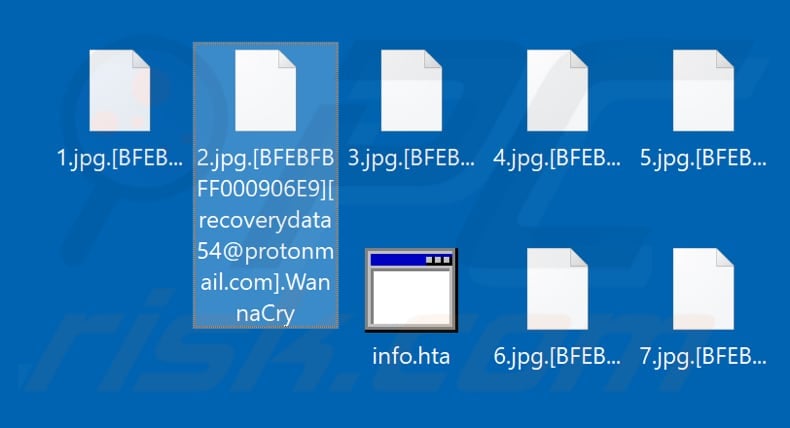
WannaCry process (disguised as "Windows Defender") in Task Director:
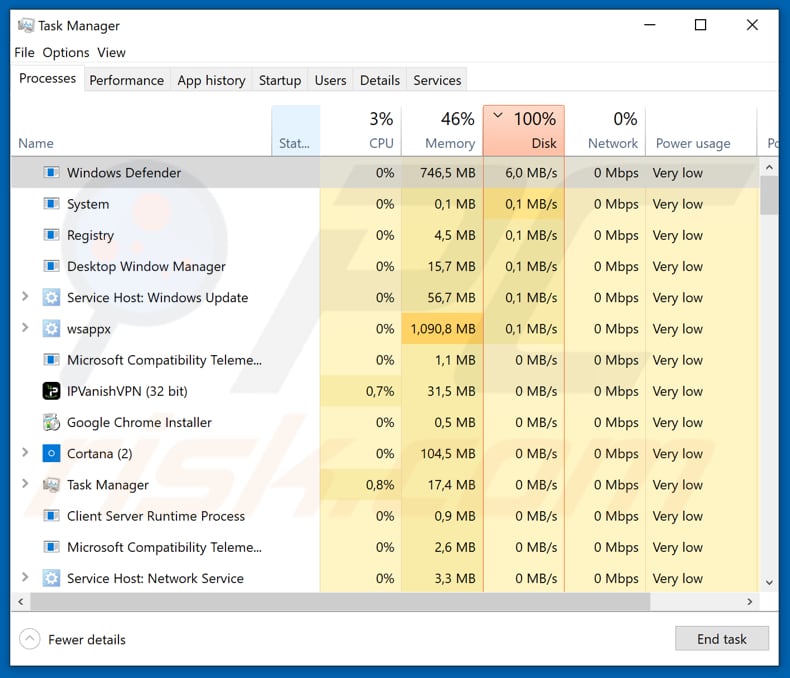
Update September 26, 2019 - the Emsisoft cyber security visitor has recently released a decryption tool capable of restoring data compromised by WannaCry (WannaCryFake) ransomware free of charge. Therefore, at that place is absolutely no need to pay. Y'all can find more information and download the tool on this web page.
Screenshot of WannaCry decryptor by Emsisoft:
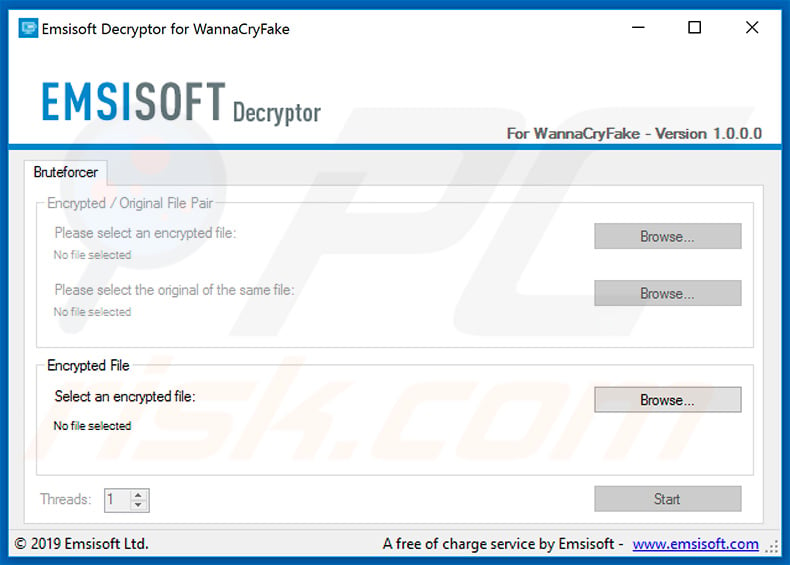
WannaCry ransomware removal:
Instant automated malware removal: Manual threat removal might be a lengthy and complicated process that requires advanced computer skills. Philharmonic Cleaner is a professional automated malware removal tool that is recommended to get rid of malware. Download it by clicking the button beneath:
▼ DOWNLOAD Combo Cleaner By downloading any software listed on this website yous concord to our Privacy Policy and Terms of Utilise. To use full-featured production, you have to purchase a license for Combo Cleaner. seven days gratuitous trial bachelor. Combo Cleaner is endemic and operated by Rcs Lt, the parent company of PCRisk.com read more.
Video suggesting what steps should be taken in example of a ransomware infection:
Quick card:
- What is WannaCry virus?
- Step 1. Reporting ransomware to authorities.
- STEP 2. Isolating the infected device.
- Footstep 3. Identifying the ransomware infection.
- Pace 4. Searching for ransomware decryption tools.
- Footstep 5. Restoring files with information recovery tools.
- Pace 6. Creating data backups.
If yous are a victim of a ransomware attack we recommend reporting this incident to authorities. Past providing information to law enforcement agencies y'all will help runway cybercrime and potentially assist in the prosecution of the attackers. Here'due south a list of authorities where you should report a ransomware attack. For the consummate list of local cybersecurity centers and data on why you should study ransomware attacks, read this article.
List of local government where ransomware attacks should exist reported (choose one depending on your residence address):
Isolating the infected device:
Some ransomware-type infections are designed to encrypt files inside external storage devices, infect them, and even spread throughout the unabridged local network. For this reason, it is very important to isolate the infected device (estimator) as presently equally possible.
Step 1: Disconnect from the internet.
The easiest way to disconnect a computer from the internet is to unplug the Ethernet cable from the motherboard, however, some devices are continued via a wireless network and for some users (specially those who are not particularly tech-savvy), disconnecting cables may seem troublesome. Therefore, you tin can also disconnect the system manually via Control Panel:
Navigate to the "Command Panel", click the search bar in the upper-right corner of the screen, enter "Network and Sharing Heart" and select search result: 
Click the "Change adapter settings" selection in the upper-left corner of the window: 
Right-click on each connectedness point and select "Disable". Once disabled, the system will no longer be connected to the cyberspace. To re-enable the connection points, simply right-click once more and select "Enable". 
Step 2: Unplug all storage devices.
As mentioned above, ransomware might encrypt information and infiltrate all storage devices that are connected to the reckoner. For this reason, all external storage devices (flash drives, portable difficult drives, etc.) should be disconnected immediately, however, we strongly advise yous to eject each device before disconnecting to prevent information corruption:
Navigate to "My Reckoner", right-click on each continued device, and select "Squirt": 
Step three: Log-out of cloud storage accounts.
Some ransomware-blazon might exist able to hijack software that handles data stored within "the Deject". Therefore, the information could be corrupted/encrypted. For this reason, you should log-out of all cloud storage accounts within browsers and other related software. You should also consider temporarily uninstalling the cloud-management software until the infection is completely removed.
Place the ransomware infection:
To properly handle an infection, 1 must first identify it. Some ransomware infections use ransom-need messages as an introduction (see the WALDO ransomware text file below).

This, however, is rare. In most cases, ransomware infections deliver more direct messages simply stating that information is encrypted and that victims must pay some sort of ransom. Note that ransomware-type infections typically generate letters with unlike file names (for example, "_readme.txt", "READ-ME.txt", "DECRYPTION_INSTRUCTIONS.txt", "DECRYPT_FILES.html", etc.). Therefore, using the name of a ransom message may seem similar a good style to identify the infection. The problem is that nigh of these names are generic and some infections use the aforementioned names, even though the delivered messages are different and the infections themselves are unrelated. Therefore, using the bulletin filename alone can exist ineffective and even lead to permanent information loss (for case, by attempting to decrypt data using tools designed for different ransomware infections, users are likely to stop up permanently damaging files and decryption will no longer be possible even with the right tool).
Another manner to identify a ransomware infection is to check the file extension, which is appended to each encrypted file. Ransomware infections are often named by the extensions they suspend (see files encrypted by Qewe ransomware below).

This method is merely constructive, however, when the appended extension is unique - many ransomware infections append a generic extension (for case, ".encrypted", ".enc", ".crypted", ".locked", etc.). In these cases, identifying ransomware past its appended extension becomes impossible.
One of the easiest and quickest ways to identify a ransomware infection is to use the ID Ransomware website. This service supports most existing ransomware infections. Victims but upload a bribe bulletin and/or one encrypted file (we suggest you to upload both if possible).

The ransomware will be identified within seconds and you will exist provided with various details, such equally the name of the malware family to which the infection belongs, whether it is decryptable, then on.
Example one (Qewe [Stop/Djvu] ransomware):

Example 2 (.iso [Phobos] ransomware):

If your data happens to be encrypted past ransomware that is not supported by ID Ransomware, you lot can always attempt searching the internet by using certain keywords (for example, a ransom message title, file extension, provided contact emails, crypto wallet addresses, etc.).
Search for ransomware decryption tools:
Encryption algorithms used past almost ransomware-type infections are extremely sophisticated and, if the encryption is performed properly, only the developer is capable of restoring data. This is considering decryption requires a specific key, which is generated during the encryption. Restoring information without the key is incommunicable. In most cases, cybercriminals store keys on a remote server, rather than using the infected motorcar every bit a host. Dharma (CrySis), Phobos, and other families of high-cease ransomware infections are virtually flawless, and thus restoring data encrypted without the developers' involvement is simply incommunicable. Despite this, there are dozens of ransomware-blazon infections that are poorly adult and contain a number of flaws (for case, the use of identical encryption/decryption keys for each victim, keys stored locally, etc.). Therefore, always cheque for available decryption tools for any ransomware that infiltrates your computer.
Finding the correct decryption tool on the internet can exist very frustrating. For this reason, we recommend that yous use the No More Ransom Project and this is where identifying the ransomware infection is useful. The No More than Ransom Project website contains a "Decryption Tools" department with a search bar. Enter the name of the identified ransomware, and all available decryptors (if there are any) volition exist listed.

Restore files with information recovery tools:
Depending on the state of affairs (quality of ransomware infection, type of encryption algorithm used, etc.), restoring data with certain third-party tools might be possible. Therefore, nosotros propose yous to employ the Recuva tool adult past CCleaner. This tool supports over a thousand information types (graphics, video, audio, documents, etc.) and it is very intuitive (little knowledge is necessary to recover data). In addition, the recovery feature is completely complimentary.
Step 1: Perform a scan.
Run the Recuva application and follow the wizard. You will be prompted with several windows assuasive you to choose what file types to look for, which locations should exist scanned, etc. All yous need to practice is select the options you're looking for and start the scan. We advise yous to enable the "Deep Scan" before starting, otherwise, the application'south scanning capabilities will be restricted.

Await for Recuva to consummate the browse. The scanning elapsing depends on the volume of files (both in quantity and size) that you are scanning (for example, several hundred gigabytes could take over an hour to scan). Therefore, exist patient during the scanning process. We also advise against modifying or deleting existing files, since this might interfere with the scan. If yous add additional data (for example, downloading files/content) while scanning, this will prolong the process:

Step 2: Recover data.
Once the process is complete, select the folders/files yous wish to restore and simply click "Recover". Note that some gratuitous space on your storage drive is necessary to restore data:

Create data backups:
Proper file management and creating backups is essential for data security. Therefore, always be very careful and recollect ahead.
Partition direction: Nosotros recommend that you lot store your data in multiple partitions and avoid storing of import files within the division that contains the unabridged operating system. If you fall into a situation whereby you lot cannot boot the system and are forced to format the disk on which the operating system is installed (in most cases, this is where malware infections hide), you will lose all data stored within that drive. This is the advantage of having multiple partitions: if you take the unabridged storage device assigned to a unmarried partition, you volition be forced to delete everything, notwithstanding, creating multiple partitions and allocating the data properly allows you to preclude such issues. You tin hands format a single partitioning without affecting the others - therefore, one volition be cleaned and the others will remain untouched, and your information volition be saved. Managing partitions is quite simple and yous can find all the necessary information on Microsoft'south documentation web page.
Data backups: One of the most reliable fill-in methods is to use an external storage device and keep it unplugged. Copy your data to an external hard drive, flash (thumb) bulldoze, SSD, HDD, or whatever other storage device, unplug it and store it in a dry place away from the sunday and extreme temperatures. This method is, nevertheless, quite inefficient, since information backups and updates need to be fabricated regularly. You can as well use a deject service or remote server. Here, an internet connexion is required and in that location is always the risk of a security breach, although it'southward a really rare occasion.
Nosotros recommend using Microsoft OneDrive for backing upwards your files. OneDrive lets you store your personal files and data in the cloud, sync files beyond computers and mobile devices, allowing you to admission and edit your files from all of your Windows devices. OneDrive lets you save, share and preview files, access download history, move, delete, and rename files, also as create new folders, and much more.
You can dorsum up your most important folders and files on your PC (your Desktop, Documents, and Pictures folders). Some of OneDrive's more notable features include file versioning, which keeps older versions of files for upward to thirty days. OneDrive features a recycling bin in which all of your deleted files are stored for a limited time. Deleted files are not counted as part of the user's allocation.
The service is built using HTML5 technologies and allows yous to upload files up to 300 MB via elevate and driblet into the spider web browser or up to x GB via the OneDrive desktop application. With OneDrive, you tin can download entire folders as a single Cipher file with up to 10,000 files, although it can't exceed 15 GB per single download.
OneDrive comes with 5 GB of free storage out of the box, with an additional 100 GB, 1 TB, and 6 TB storage options available for a subscription-based fee. You lot can get one of these storage plans by either purchasing additional storage separately or with Office 365 subscription.
Creating a data backup:
The backup process is the same for all file types and folders. Here'southward how you can support your files using Microsoft OneDrive
Stride 1: Cull the files/folders you lot want to backup.

Click the OneDrive cloud icon to open the OneDrive menu. While in this menu, you tin customize your file backup settings.

Click Help & Settings and and so select Settings from the drop-down menu.

Go to the Backup tab and click Manage backup.
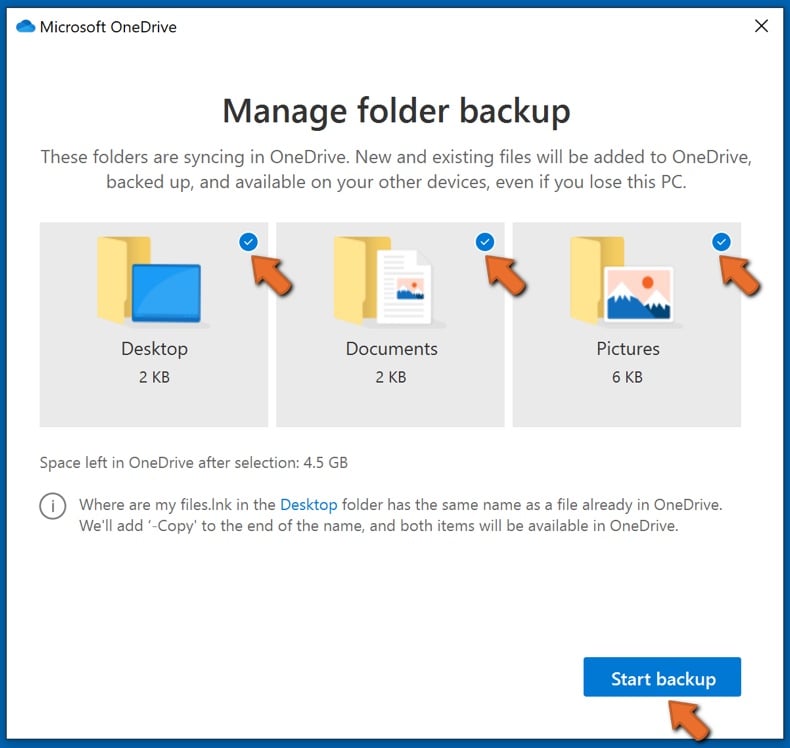
In this menu, you lot can choose to fill-in the Desktop and all of the files on information technology, and Documents and Pictures folders, over again, with all of the files in them. Click Commencement fill-in.
At present, when you add a file or folder in the Desktop and Documents and Pictures folders, they will be automatically backed up on OneDrive.
To add together folders and files, not in the locations shown above, you have to add them manually.

Open up File Explorer and navigate to the location of the folder/file yous want to backup. Select the detail, right-click it, and click Copy.

Then, navigate to OneDrive, right-click anywhere in the window and click Paste. Alternatively, you tin just drag and driblet a file into OneDrive. OneDrive will automatically create a fill-in of the folder/file.

All of the files added to the OneDrive folder are backed up in the cloud automatically. The green circle with the checkmark in information technology indicates that the file is available both locally and on OneDrive and that the file version is the same on both. The blue cloud icon indicates that the file has not been synced and is available only on OneDrive. The sync icon indicates that the file is currently syncing.
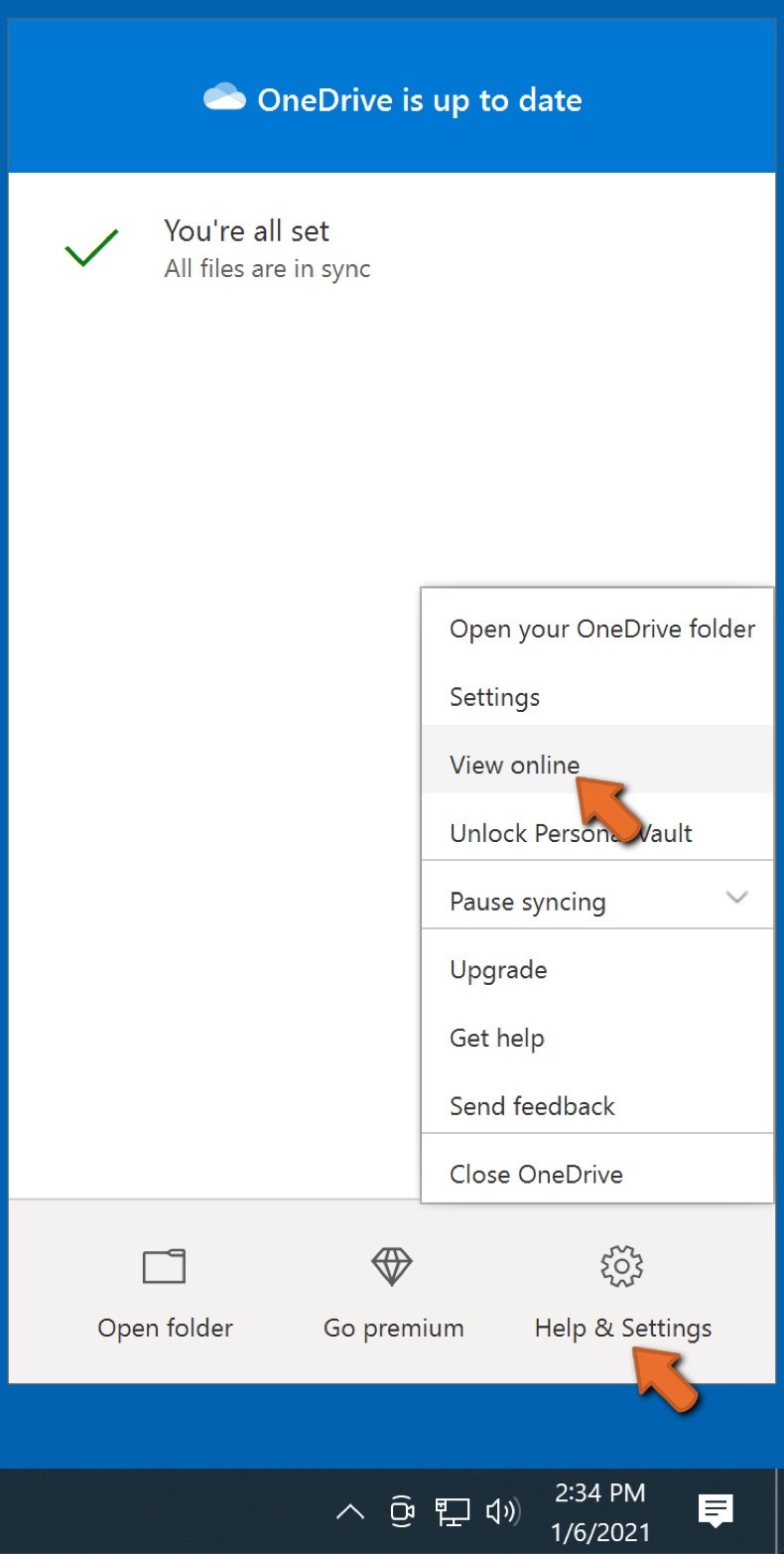
To access files only located on OneDrive online, become to the Help & Settings drop-down menu and select View online.

Step 2: Restore corrupted files.
OneDrive makes certain that the files stay in sync, so the version of the file on the computer is the same version on the deject. However, if ransomware has encrypted your files, you can take advantage of OneDrive's Version history characteristic that will let you to restore the file versions prior to encryption.
Microsoft 365 has a ransomware detection feature that notifies you when your OneDrive files have been attacked and guide you lot through the process of restoring your files. It must be noted, however, that if y'all don't have a paid Microsoft 365 subscription, you only get one detection and file recovery for free.
If your OneDrive files go deleted, corrupted, or infected by malware, you tin restore your entire OneDrive to a previous state. Here'due south how y'all can restore your entire OneDrive:

ane. If you're signed in with a personal account, click the Settings cog at the top of the page. Then, click Options and select Restore your OneDrive.
If you're signed in with a work or school account, click the Settings cog at the top of the page. And then, click Restore your OneDrive.
2. On the Restore your OneDrive page, select a date from the drop-downward listing. Note that if you're restoring your files after automatic ransomware detection, a restore date volition be selected for you.
iii. After configuring all of the file restoration options, click Restore to disengage all the activities y'all selected.
The best way to avoid damage from ransomware infections is to maintain regular up-to-date backups.
About the author:

Tomas Meskauskas - expert security researcher, professional malware analyst.
I am passionate about computer security and technology. I accept an feel of over 10 years working in various companies related to computer technical result solving and Internet security. I take been working equally an author and editor for pcrisk.com since 2010. Follow me on Twitter and LinkedIn to stay informed about the latest online security threats. Contact Tomas Meskauskas.
PCrisk security portal is brought by a company RCS LT. Joined forces of security researchers help educate figurer users nearly the latest online security threats. More information about the company RCS LT.
Our malware removal guides are free. However, if yous desire to support u.s.a. you lot can send us a donation.
Source: https://www.pcrisk.com/removal-guides/15883-wannacry-ransomware
Posted by: garnerrodn1986.blogspot.com

0 Response to "How To Remove Wannacry Ransomware From Windows 7"
Post a Comment